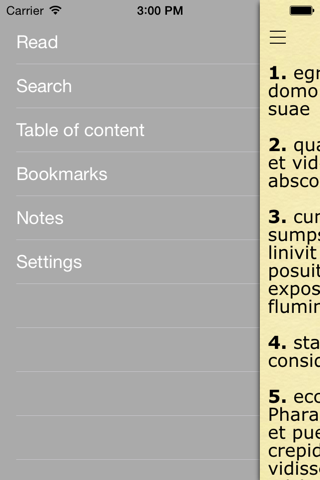
Latin Vulgate (Biblia Sacra Vulgata Latina) app for iPhone and iPad
Developer: Oleg Shukalovich
First release : 01 Apr 2015
App size: 10.35 Mb
Biblia Sacra Vulgata Latina
The Vulgate is a late 4th-century Latin translation of the Bible. It was largely the work of St. Jerome, who was commissioned by Pope Damasus I in 382 to make a revision of the Vetus Latina (old Latin translations). Its widespread adoption eventually led to their eclipse. By the 13th century this revision had come to be called the versio vulgata, that is, the "commonly used translation". In the 16th century it became the definitive and officially promulgated Latin version of the Bible in the Roman Catholic Church.
Before the publication of Pius XIIs Divino Afflante Spiritu, the Vulgate was the source text used for many translations of the Bible into vernacular languages. In English, the interlinear translation of the Lindisfarne Gospels as well as other Old English Bible translations, the translation of John Wycliffe, the Douay-Rheims Bible, the Confraternity Bible, and Ronald Knoxs translation were all made from the Vulgate.
The Vulgate has a compound text that is not entirely the work of Jerome.[2] Its components include:
- Jeromes independent translation from the Hebrew: the books of the Hebrew Bible, usually not including his translation of the Psalms. This was completed in 405.
- Translation from the Greek of Theodotion by Jerome: The three additions to the Book of Daniel; Song of the Three Children, Story of Susanna, and The Idol Bel and the Dragon. The Song of the Three Children was retained within the narrative of Daniel, the other two additions Jerome moved to the end of the book.
- Translation from the Septuagint by Jerome: the Rest of Esther. Jerome gathered all these additions together at the end of the book of Esther.
- Translation from the Hexaplar Septuagint by Jerome: his Gallican version of the Book of Psalms. Jeromes Hexaplaric revisions of other books of Old Testament continued to circulate in Italy for several centuries, but only Job and fragments of other books survive.
- Free translation by Jerome from a secondary Aramaic version: Tobias and Judith.
- Revision by Jerome of the Old Latin, corrected with reference to the oldest Greek manuscripts available: the Gospels.
- Old Latin, more or less revised by a person or persons unknown: Baruch, Letter of Jeremiah, 3 Esdras,[3] Acts, Epistles, and the Apocalypse.
- Old Latin, wholly unrevised: Epistle to the Laodiceans, Prayer of Manasses, 4 Esdras, Wisdom, Ecclesiasticus, and 1 and 2 Maccabees.
Jerome did not embark on the work with the intention of creating a new version of the whole Bible, but the changing nature of his program can be tracked in his voluminous correspondence. He had been commissioned by Damasus I in 382 to revise the Old Latin text of the four Gospels from the best Greek texts, and by the time of Damasus death in 384 he had thoroughly completed this task, together with a more cursory revision from the Greek Septuagint of the Old Latin text of the Psalms in the Roman Psalter which is now lost. How much of the rest of the New Testament he then revised is difficult to judge today, but little of his work survived in the Vulgate text.
The Vulgate is usually credited as being the first translation of the Old Testament into Latin directly from the Hebrew Tanakh, rather than the Greek Septuagint. Jeromes extensive use of exegetical material written in Greek, on the other hand, as well as his use of the Aquiline and Theodotiontic columns of the Hexapla, along with the somewhat paraphrastic style in which he translated makes it difficult to determine exactly how direct the conversion of Hebrew to Latin was.



